PGBM144 Assignment: Exchange Rate Volatility and Risk Management
VerifiedAdded on 2023/01/10
|21
|7200
|88
Homework Assignment
AI Summary
This assignment delves into the complexities of international financial markets, focusing on exchange rate volatility and its impact on international trade. The analysis begins by identifying the main causes of exchange rate fluctuations in the foreign exchange market, referencing inflation rates, interest rates, current accounts, government debt, terms of trade, political stability, recession, and speculation. It then explores how this volatility affects international businesses, considering both positive and negative impacts based on factors like forward activity and market structure. The assignment further investigates the nature of potential risks in international transactions, including commercial, political, legal, cargo, and credit risks. Finally, it examines how international traders can manage these risks through derivative markets, particularly commodity and stock market risk, using futures contracts and options to mitigate potential losses. The document incorporates relevant financial data, charts, and academic literature to support its arguments, providing a comprehensive overview of the subject matter.
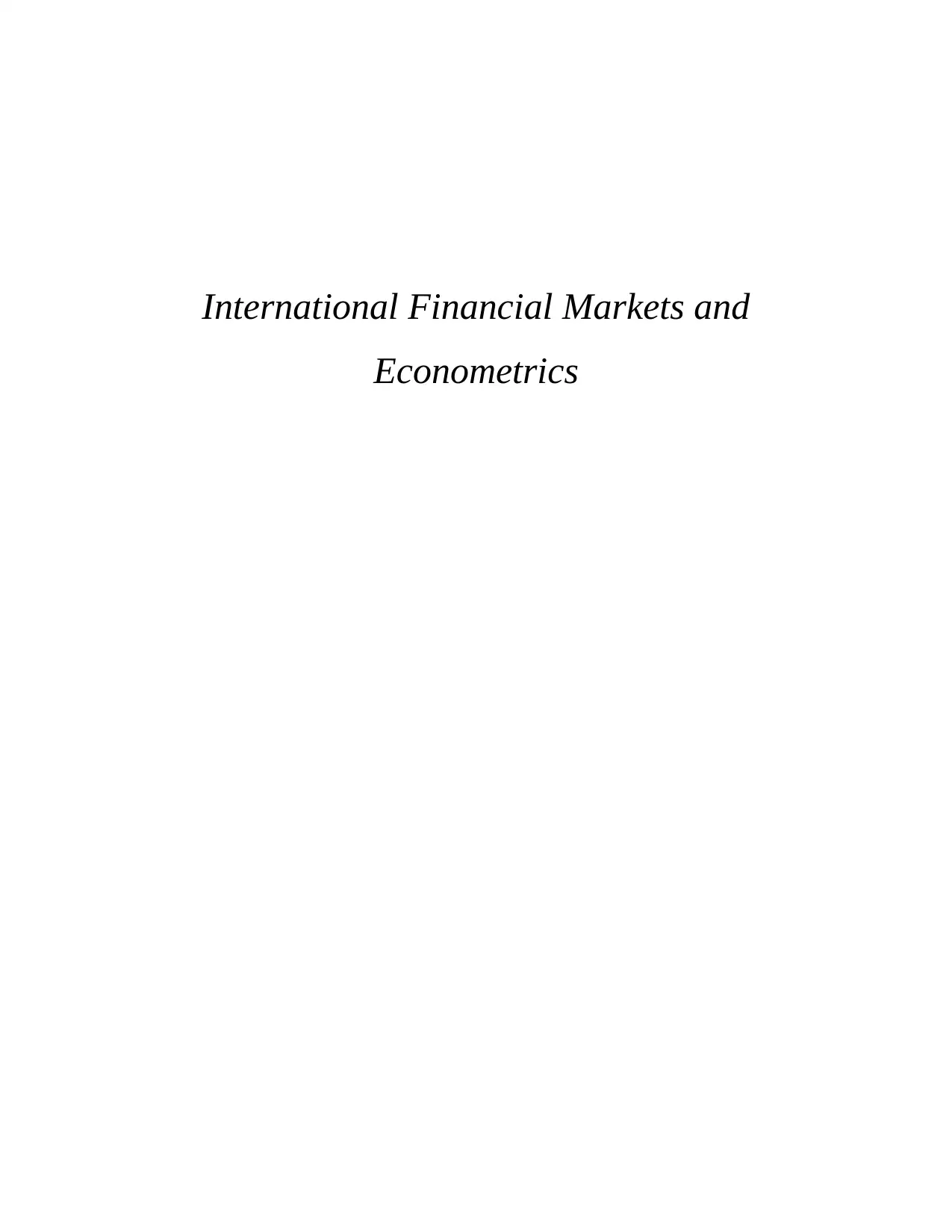
International Financial Markets and
Econometrics
Econometrics
Paraphrase This Document
Need a fresh take? Get an instant paraphrase of this document with our AI Paraphraser
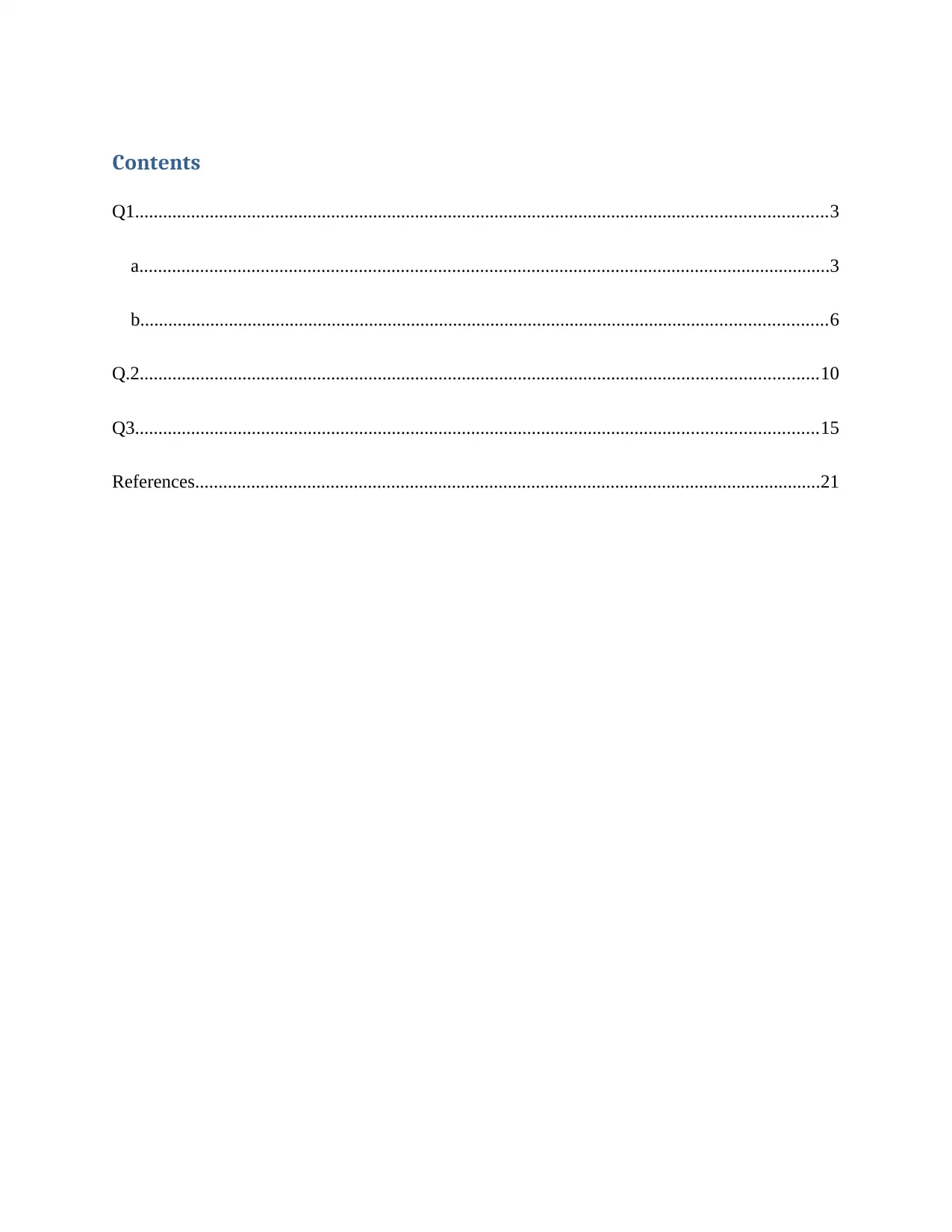
Contents
Q1....................................................................................................................................................3
a....................................................................................................................................................3
b...................................................................................................................................................6
Q.2.................................................................................................................................................10
Q3..................................................................................................................................................15
References......................................................................................................................................21
Q1....................................................................................................................................................3
a....................................................................................................................................................3
b...................................................................................................................................................6
Q.2.................................................................................................................................................10
Q3..................................................................................................................................................15
References......................................................................................................................................21
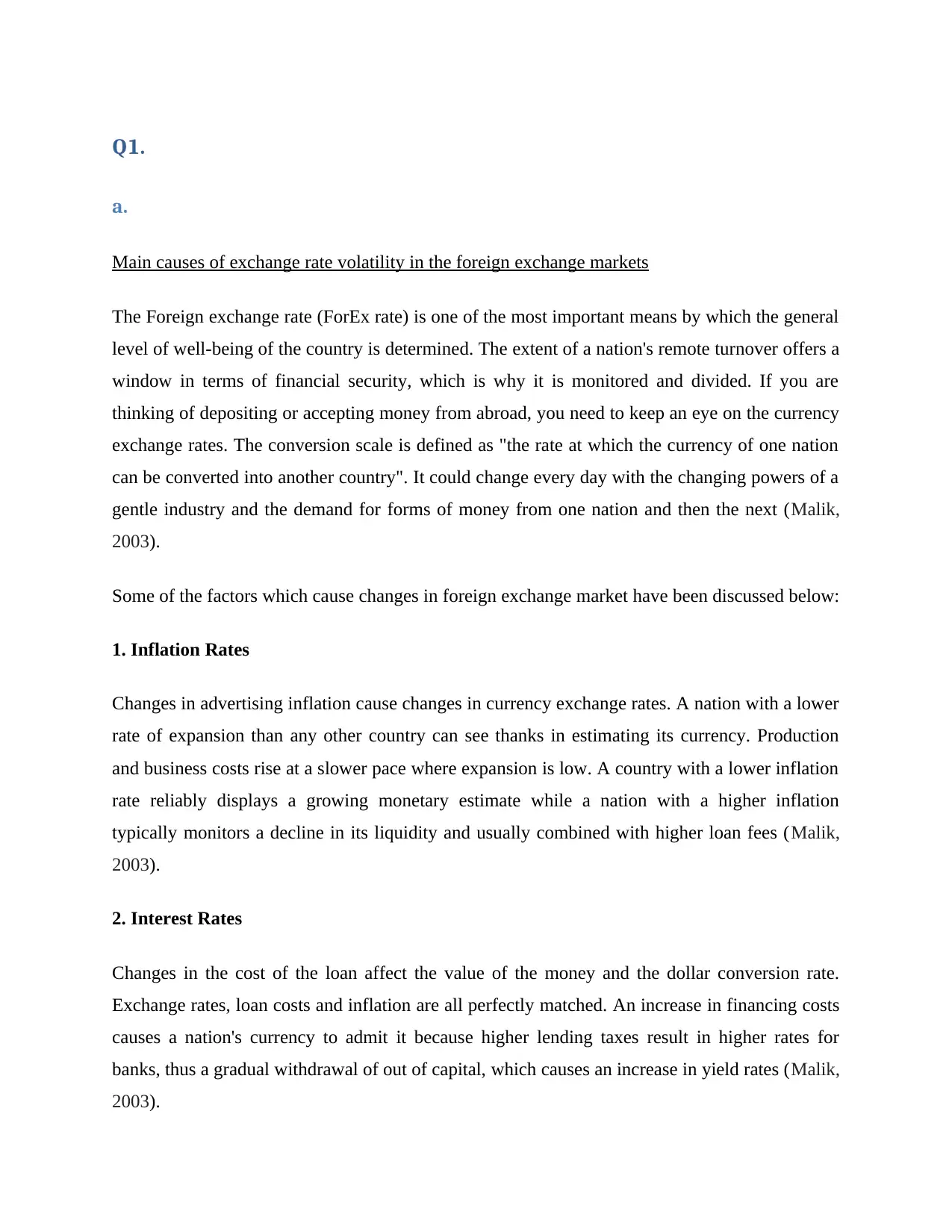
Q1.
a.
Main causes of exchange rate volatility in the foreign exchange markets
The Foreign exchange rate (ForEx rate) is one of the most important means by which the general
level of well-being of the country is determined. The extent of a nation's remote turnover offers a
window in terms of financial security, which is why it is monitored and divided. If you are
thinking of depositing or accepting money from abroad, you need to keep an eye on the currency
exchange rates. The conversion scale is defined as "the rate at which the currency of one nation
can be converted into another country". It could change every day with the changing powers of a
gentle industry and the demand for forms of money from one nation and then the next (Malik,
2003).
Some of the factors which cause changes in foreign exchange market have been discussed below:
1. Inflation Rates
Changes in advertising inflation cause changes in currency exchange rates. A nation with a lower
rate of expansion than any other country can see thanks in estimating its currency. Production
and business costs rise at a slower pace where expansion is low. A country with a lower inflation
rate reliably displays a growing monetary estimate while a nation with a higher inflation
typically monitors a decline in its liquidity and usually combined with higher loan fees (Malik,
2003).
2. Interest Rates
Changes in the cost of the loan affect the value of the money and the dollar conversion rate.
Exchange rates, loan costs and inflation are all perfectly matched. An increase in financing costs
causes a nation's currency to admit it because higher lending taxes result in higher rates for
banks, thus a gradual withdrawal of out of capital, which causes an increase in yield rates (Malik,
2003).
a.
Main causes of exchange rate volatility in the foreign exchange markets
The Foreign exchange rate (ForEx rate) is one of the most important means by which the general
level of well-being of the country is determined. The extent of a nation's remote turnover offers a
window in terms of financial security, which is why it is monitored and divided. If you are
thinking of depositing or accepting money from abroad, you need to keep an eye on the currency
exchange rates. The conversion scale is defined as "the rate at which the currency of one nation
can be converted into another country". It could change every day with the changing powers of a
gentle industry and the demand for forms of money from one nation and then the next (Malik,
2003).
Some of the factors which cause changes in foreign exchange market have been discussed below:
1. Inflation Rates
Changes in advertising inflation cause changes in currency exchange rates. A nation with a lower
rate of expansion than any other country can see thanks in estimating its currency. Production
and business costs rise at a slower pace where expansion is low. A country with a lower inflation
rate reliably displays a growing monetary estimate while a nation with a higher inflation
typically monitors a decline in its liquidity and usually combined with higher loan fees (Malik,
2003).
2. Interest Rates
Changes in the cost of the loan affect the value of the money and the dollar conversion rate.
Exchange rates, loan costs and inflation are all perfectly matched. An increase in financing costs
causes a nation's currency to admit it because higher lending taxes result in higher rates for
banks, thus a gradual withdrawal of out of capital, which causes an increase in yield rates (Malik,
2003).
⊘ This is a preview!⊘
Do you want full access?
Subscribe today to unlock all pages.

Trusted by 1+ million students worldwide
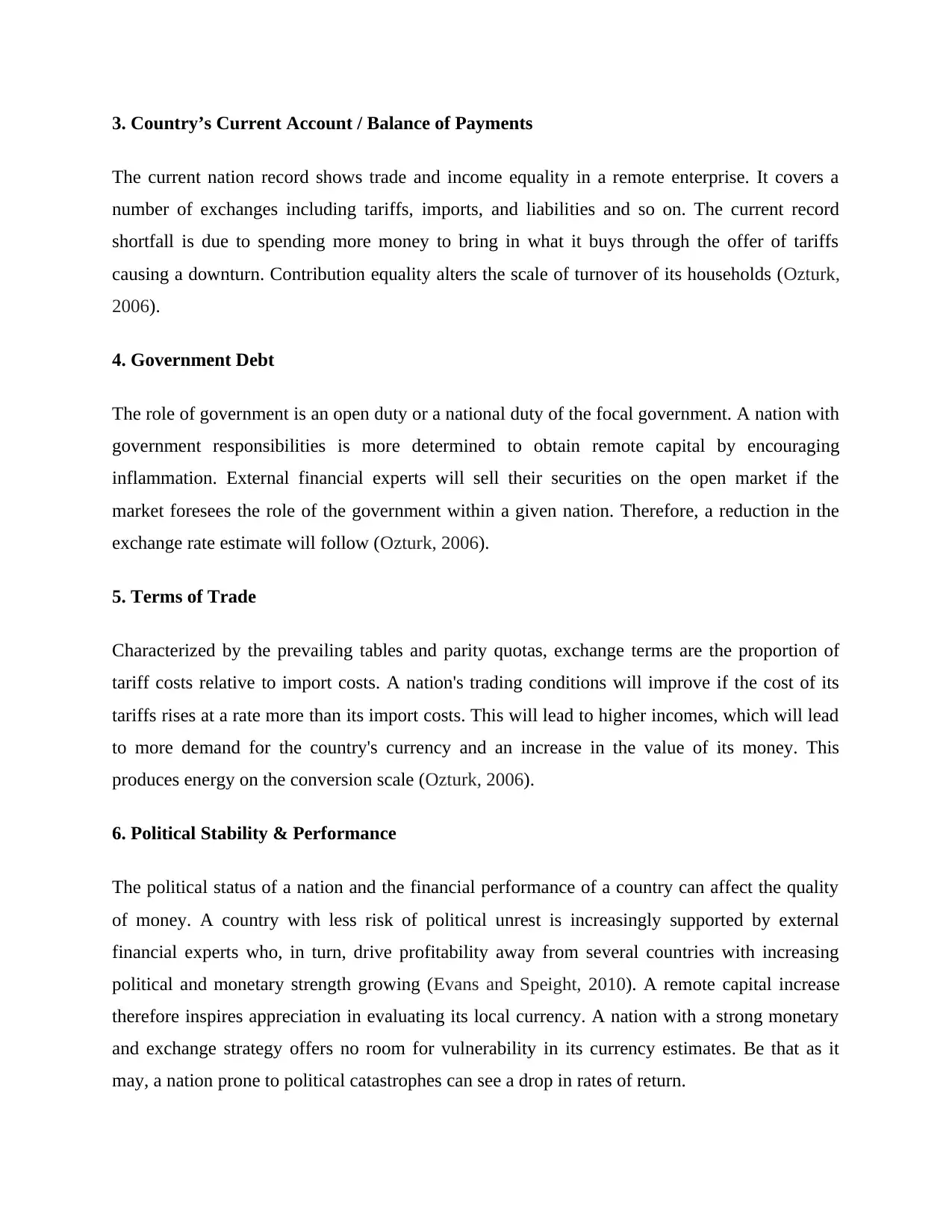
3. Country’s Current Account / Balance of Payments
The current nation record shows trade and income equality in a remote enterprise. It covers a
number of exchanges including tariffs, imports, and liabilities and so on. The current record
shortfall is due to spending more money to bring in what it buys through the offer of tariffs
causing a downturn. Contribution equality alters the scale of turnover of its households (Ozturk,
2006).
4. Government Debt
The role of government is an open duty or a national duty of the focal government. A nation with
government responsibilities is more determined to obtain remote capital by encouraging
inflammation. External financial experts will sell their securities on the open market if the
market foresees the role of the government within a given nation. Therefore, a reduction in the
exchange rate estimate will follow (Ozturk, 2006).
5. Terms of Trade
Characterized by the prevailing tables and parity quotas, exchange terms are the proportion of
tariff costs relative to import costs. A nation's trading conditions will improve if the cost of its
tariffs rises at a rate more than its import costs. This will lead to higher incomes, which will lead
to more demand for the country's currency and an increase in the value of its money. This
produces energy on the conversion scale (Ozturk, 2006).
6. Political Stability & Performance
The political status of a nation and the financial performance of a country can affect the quality
of money. A country with less risk of political unrest is increasingly supported by external
financial experts who, in turn, drive profitability away from several countries with increasing
political and monetary strength growing (Evans and Speight, 2010). A remote capital increase
therefore inspires appreciation in evaluating its local currency. A nation with a strong monetary
and exchange strategy offers no room for vulnerability in its currency estimates. Be that as it
may, a nation prone to political catastrophes can see a drop in rates of return.
The current nation record shows trade and income equality in a remote enterprise. It covers a
number of exchanges including tariffs, imports, and liabilities and so on. The current record
shortfall is due to spending more money to bring in what it buys through the offer of tariffs
causing a downturn. Contribution equality alters the scale of turnover of its households (Ozturk,
2006).
4. Government Debt
The role of government is an open duty or a national duty of the focal government. A nation with
government responsibilities is more determined to obtain remote capital by encouraging
inflammation. External financial experts will sell their securities on the open market if the
market foresees the role of the government within a given nation. Therefore, a reduction in the
exchange rate estimate will follow (Ozturk, 2006).
5. Terms of Trade
Characterized by the prevailing tables and parity quotas, exchange terms are the proportion of
tariff costs relative to import costs. A nation's trading conditions will improve if the cost of its
tariffs rises at a rate more than its import costs. This will lead to higher incomes, which will lead
to more demand for the country's currency and an increase in the value of its money. This
produces energy on the conversion scale (Ozturk, 2006).
6. Political Stability & Performance
The political status of a nation and the financial performance of a country can affect the quality
of money. A country with less risk of political unrest is increasingly supported by external
financial experts who, in turn, drive profitability away from several countries with increasing
political and monetary strength growing (Evans and Speight, 2010). A remote capital increase
therefore inspires appreciation in evaluating its local currency. A nation with a strong monetary
and exchange strategy offers no room for vulnerability in its currency estimates. Be that as it
may, a nation prone to political catastrophes can see a drop in rates of return.
Paraphrase This Document
Need a fresh take? Get an instant paraphrase of this document with our AI Paraphraser
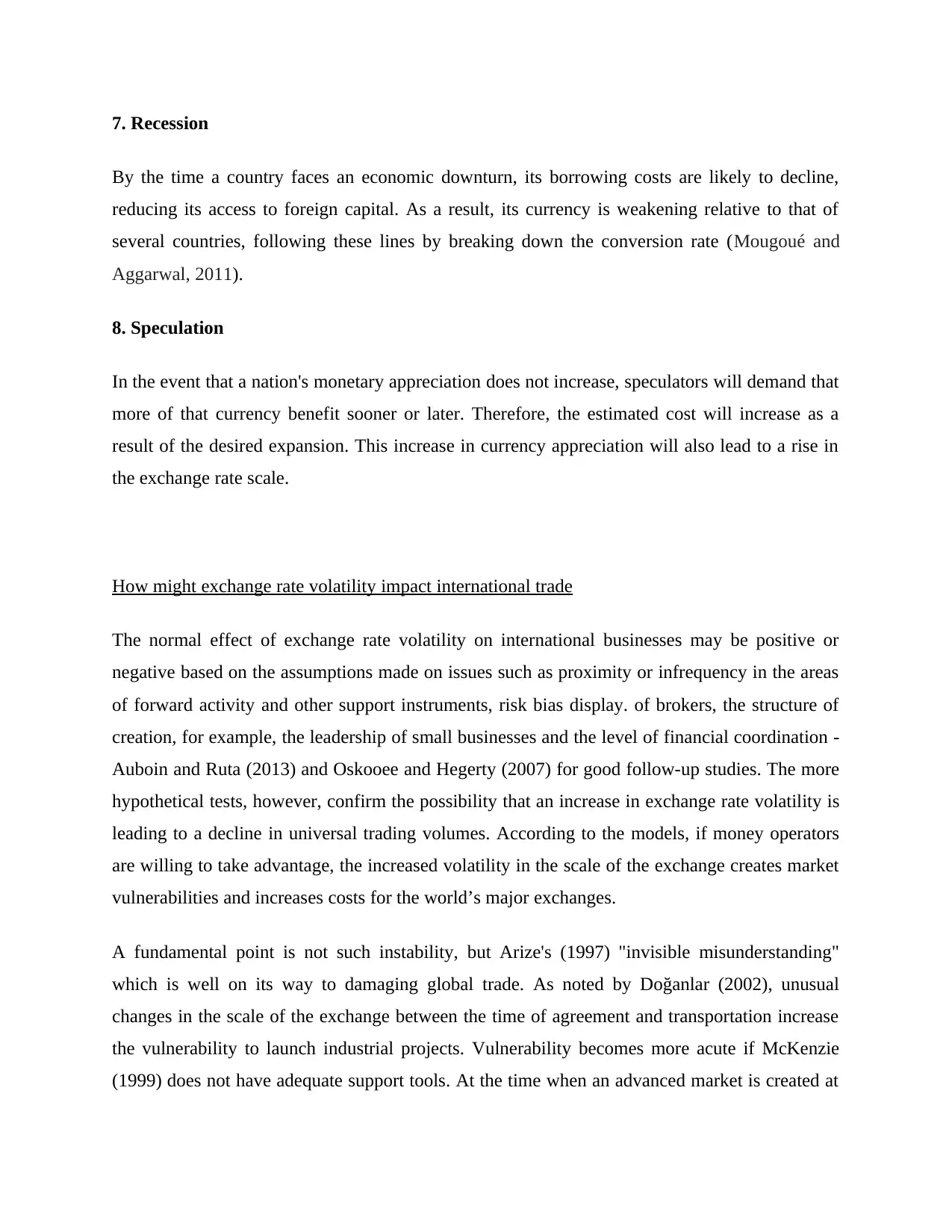
7. Recession
By the time a country faces an economic downturn, its borrowing costs are likely to decline,
reducing its access to foreign capital. As a result, its currency is weakening relative to that of
several countries, following these lines by breaking down the conversion rate (Mougoué and
Aggarwal, 2011).
8. Speculation
In the event that a nation's monetary appreciation does not increase, speculators will demand that
more of that currency benefit sooner or later. Therefore, the estimated cost will increase as a
result of the desired expansion. This increase in currency appreciation will also lead to a rise in
the exchange rate scale.
How might exchange rate volatility impact international trade
The normal effect of exchange rate volatility on international businesses may be positive or
negative based on the assumptions made on issues such as proximity or infrequency in the areas
of forward activity and other support instruments, risk bias display. of brokers, the structure of
creation, for example, the leadership of small businesses and the level of financial coordination -
Auboin and Ruta (2013) and Oskooee and Hegerty (2007) for good follow-up studies. The more
hypothetical tests, however, confirm the possibility that an increase in exchange rate volatility is
leading to a decline in universal trading volumes. According to the models, if money operators
are willing to take advantage, the increased volatility in the scale of the exchange creates market
vulnerabilities and increases costs for the world’s major exchanges.
A fundamental point is not such instability, but Arize's (1997) "invisible misunderstanding"
which is well on its way to damaging global trade. As noted by Doğanlar (2002), unusual
changes in the scale of the exchange between the time of agreement and transportation increase
the vulnerability to launch industrial projects. Vulnerability becomes more acute if McKenzie
(1999) does not have adequate support tools. At the time when an advanced market is created at
By the time a country faces an economic downturn, its borrowing costs are likely to decline,
reducing its access to foreign capital. As a result, its currency is weakening relative to that of
several countries, following these lines by breaking down the conversion rate (Mougoué and
Aggarwal, 2011).
8. Speculation
In the event that a nation's monetary appreciation does not increase, speculators will demand that
more of that currency benefit sooner or later. Therefore, the estimated cost will increase as a
result of the desired expansion. This increase in currency appreciation will also lead to a rise in
the exchange rate scale.
How might exchange rate volatility impact international trade
The normal effect of exchange rate volatility on international businesses may be positive or
negative based on the assumptions made on issues such as proximity or infrequency in the areas
of forward activity and other support instruments, risk bias display. of brokers, the structure of
creation, for example, the leadership of small businesses and the level of financial coordination -
Auboin and Ruta (2013) and Oskooee and Hegerty (2007) for good follow-up studies. The more
hypothetical tests, however, confirm the possibility that an increase in exchange rate volatility is
leading to a decline in universal trading volumes. According to the models, if money operators
are willing to take advantage, the increased volatility in the scale of the exchange creates market
vulnerabilities and increases costs for the world’s major exchanges.
A fundamental point is not such instability, but Arize's (1997) "invisible misunderstanding"
which is well on its way to damaging global trade. As noted by Doğanlar (2002), unusual
changes in the scale of the exchange between the time of agreement and transportation increase
the vulnerability to launch industrial projects. Vulnerability becomes more acute if McKenzie
(1999) does not have adequate support tools. At the time when an advanced market is created at
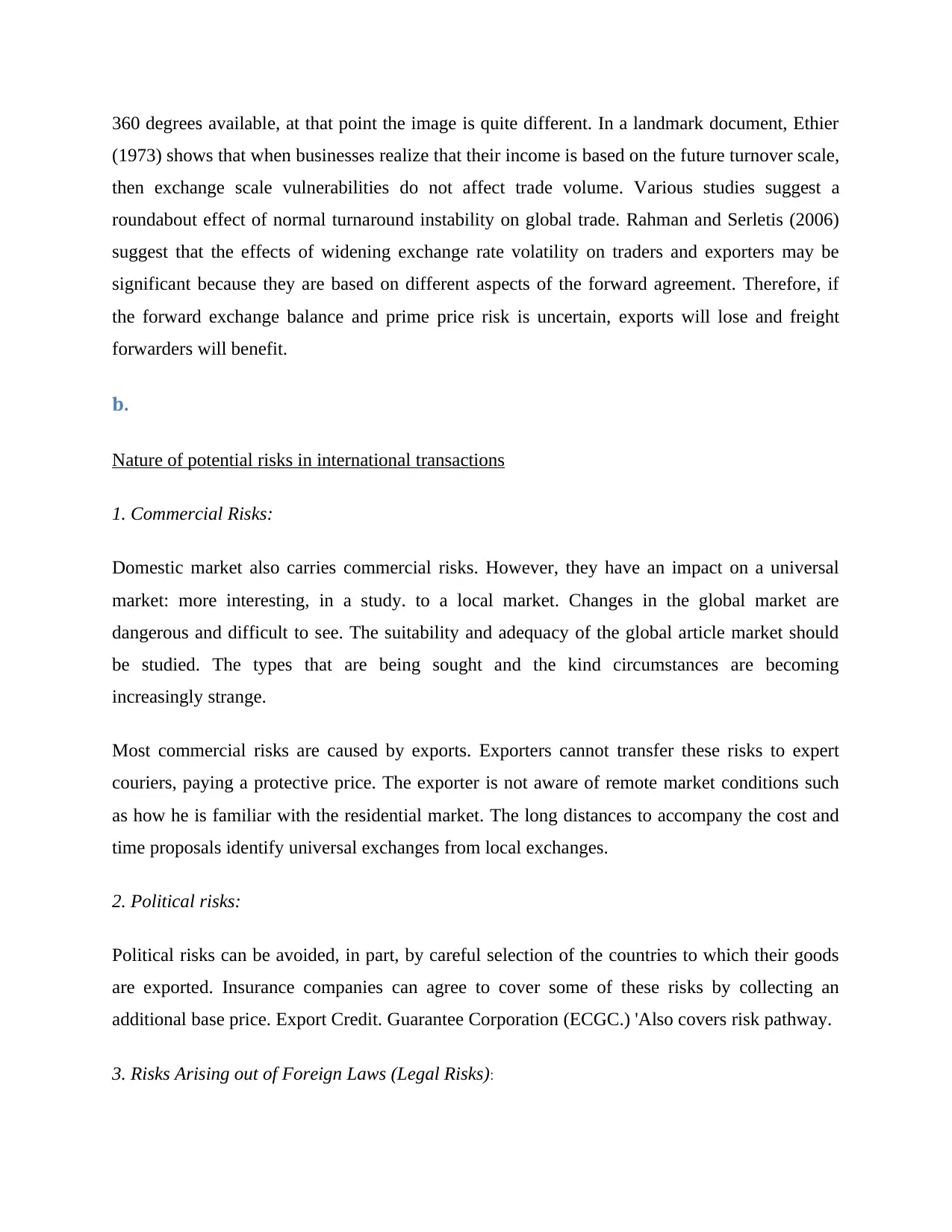
360 degrees available, at that point the image is quite different. In a landmark document, Ethier
(1973) shows that when businesses realize that their income is based on the future turnover scale,
then exchange scale vulnerabilities do not affect trade volume. Various studies suggest a
roundabout effect of normal turnaround instability on global trade. Rahman and Serletis (2006)
suggest that the effects of widening exchange rate volatility on traders and exporters may be
significant because they are based on different aspects of the forward agreement. Therefore, if
the forward exchange balance and prime price risk is uncertain, exports will lose and freight
forwarders will benefit.
b.
Nature of potential risks in international transactions
1. Commercial Risks:
Domestic market also carries commercial risks. However, they have an impact on a universal
market: more interesting, in a study. to a local market. Changes in the global market are
dangerous and difficult to see. The suitability and adequacy of the global article market should
be studied. The types that are being sought and the kind circumstances are becoming
increasingly strange.
Most commercial risks are caused by exports. Exporters cannot transfer these risks to expert
couriers, paying a protective price. The exporter is not aware of remote market conditions such
as how he is familiar with the residential market. The long distances to accompany the cost and
time proposals identify universal exchanges from local exchanges.
2. Political risks:
Political risks can be avoided, in part, by careful selection of the countries to which their goods
are exported. Insurance companies can agree to cover some of these risks by collecting an
additional base price. Export Credit. Guarantee Corporation (ECGC.) 'Also covers risk pathway.
3. Risks Arising out of Foreign Laws (Legal Risks):
(1973) shows that when businesses realize that their income is based on the future turnover scale,
then exchange scale vulnerabilities do not affect trade volume. Various studies suggest a
roundabout effect of normal turnaround instability on global trade. Rahman and Serletis (2006)
suggest that the effects of widening exchange rate volatility on traders and exporters may be
significant because they are based on different aspects of the forward agreement. Therefore, if
the forward exchange balance and prime price risk is uncertain, exports will lose and freight
forwarders will benefit.
b.
Nature of potential risks in international transactions
1. Commercial Risks:
Domestic market also carries commercial risks. However, they have an impact on a universal
market: more interesting, in a study. to a local market. Changes in the global market are
dangerous and difficult to see. The suitability and adequacy of the global article market should
be studied. The types that are being sought and the kind circumstances are becoming
increasingly strange.
Most commercial risks are caused by exports. Exporters cannot transfer these risks to expert
couriers, paying a protective price. The exporter is not aware of remote market conditions such
as how he is familiar with the residential market. The long distances to accompany the cost and
time proposals identify universal exchanges from local exchanges.
2. Political risks:
Political risks can be avoided, in part, by careful selection of the countries to which their goods
are exported. Insurance companies can agree to cover some of these risks by collecting an
additional base price. Export Credit. Guarantee Corporation (ECGC.) 'Also covers risk pathway.
3. Risks Arising out of Foreign Laws (Legal Risks):
⊘ This is a preview!⊘
Do you want full access?
Subscribe today to unlock all pages.

Trusted by 1+ million students worldwide
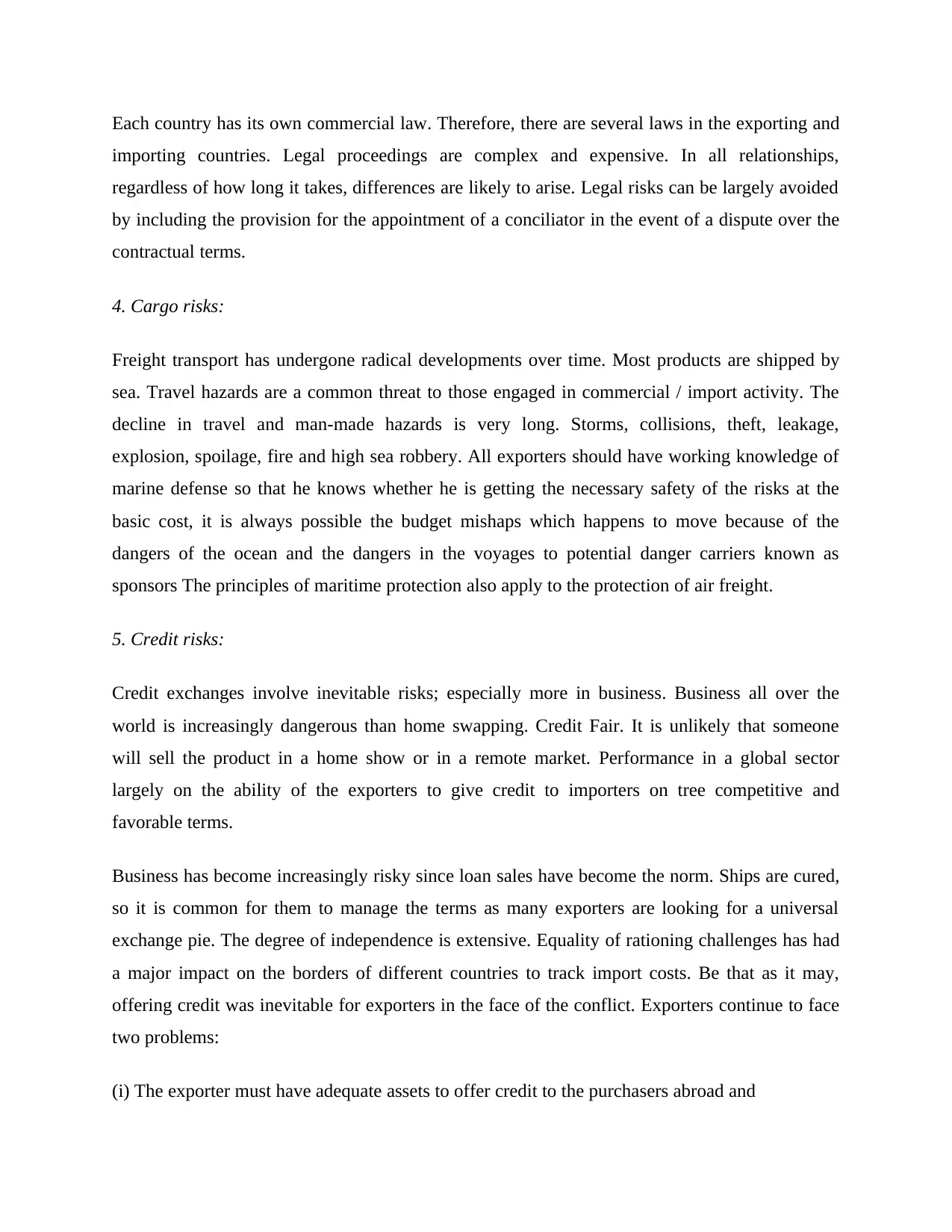
Each country has its own commercial law. Therefore, there are several laws in the exporting and
importing countries. Legal proceedings are complex and expensive. In all relationships,
regardless of how long it takes, differences are likely to arise. Legal risks can be largely avoided
by including the provision for the appointment of a conciliator in the event of a dispute over the
contractual terms.
4. Cargo risks:
Freight transport has undergone radical developments over time. Most products are shipped by
sea. Travel hazards are a common threat to those engaged in commercial / import activity. The
decline in travel and man-made hazards is very long. Storms, collisions, theft, leakage,
explosion, spoilage, fire and high sea robbery. All exporters should have working knowledge of
marine defense so that he knows whether he is getting the necessary safety of the risks at the
basic cost, it is always possible the budget mishaps which happens to move because of the
dangers of the ocean and the dangers in the voyages to potential danger carriers known as
sponsors The principles of maritime protection also apply to the protection of air freight.
5. Credit risks:
Credit exchanges involve inevitable risks; especially more in business. Business all over the
world is increasingly dangerous than home swapping. Credit Fair. It is unlikely that someone
will sell the product in a home show or in a remote market. Performance in a global sector
largely on the ability of the exporters to give credit to importers on tree competitive and
favorable terms.
Business has become increasingly risky since loan sales have become the norm. Ships are cured,
so it is common for them to manage the terms as many exporters are looking for a universal
exchange pie. The degree of independence is extensive. Equality of rationing challenges has had
a major impact on the borders of different countries to track import costs. Be that as it may,
offering credit was inevitable for exporters in the face of the conflict. Exporters continue to face
two problems:
(i) The exporter must have adequate assets to offer credit to the purchasers abroad and
importing countries. Legal proceedings are complex and expensive. In all relationships,
regardless of how long it takes, differences are likely to arise. Legal risks can be largely avoided
by including the provision for the appointment of a conciliator in the event of a dispute over the
contractual terms.
4. Cargo risks:
Freight transport has undergone radical developments over time. Most products are shipped by
sea. Travel hazards are a common threat to those engaged in commercial / import activity. The
decline in travel and man-made hazards is very long. Storms, collisions, theft, leakage,
explosion, spoilage, fire and high sea robbery. All exporters should have working knowledge of
marine defense so that he knows whether he is getting the necessary safety of the risks at the
basic cost, it is always possible the budget mishaps which happens to move because of the
dangers of the ocean and the dangers in the voyages to potential danger carriers known as
sponsors The principles of maritime protection also apply to the protection of air freight.
5. Credit risks:
Credit exchanges involve inevitable risks; especially more in business. Business all over the
world is increasingly dangerous than home swapping. Credit Fair. It is unlikely that someone
will sell the product in a home show or in a remote market. Performance in a global sector
largely on the ability of the exporters to give credit to importers on tree competitive and
favorable terms.
Business has become increasingly risky since loan sales have become the norm. Ships are cured,
so it is common for them to manage the terms as many exporters are looking for a universal
exchange pie. The degree of independence is extensive. Equality of rationing challenges has had
a major impact on the borders of different countries to track import costs. Be that as it may,
offering credit was inevitable for exporters in the face of the conflict. Exporters continue to face
two problems:
(i) The exporter must have adequate assets to offer credit to the purchasers abroad and
Paraphrase This Document
Need a fresh take? Get an instant paraphrase of this document with our AI Paraphraser
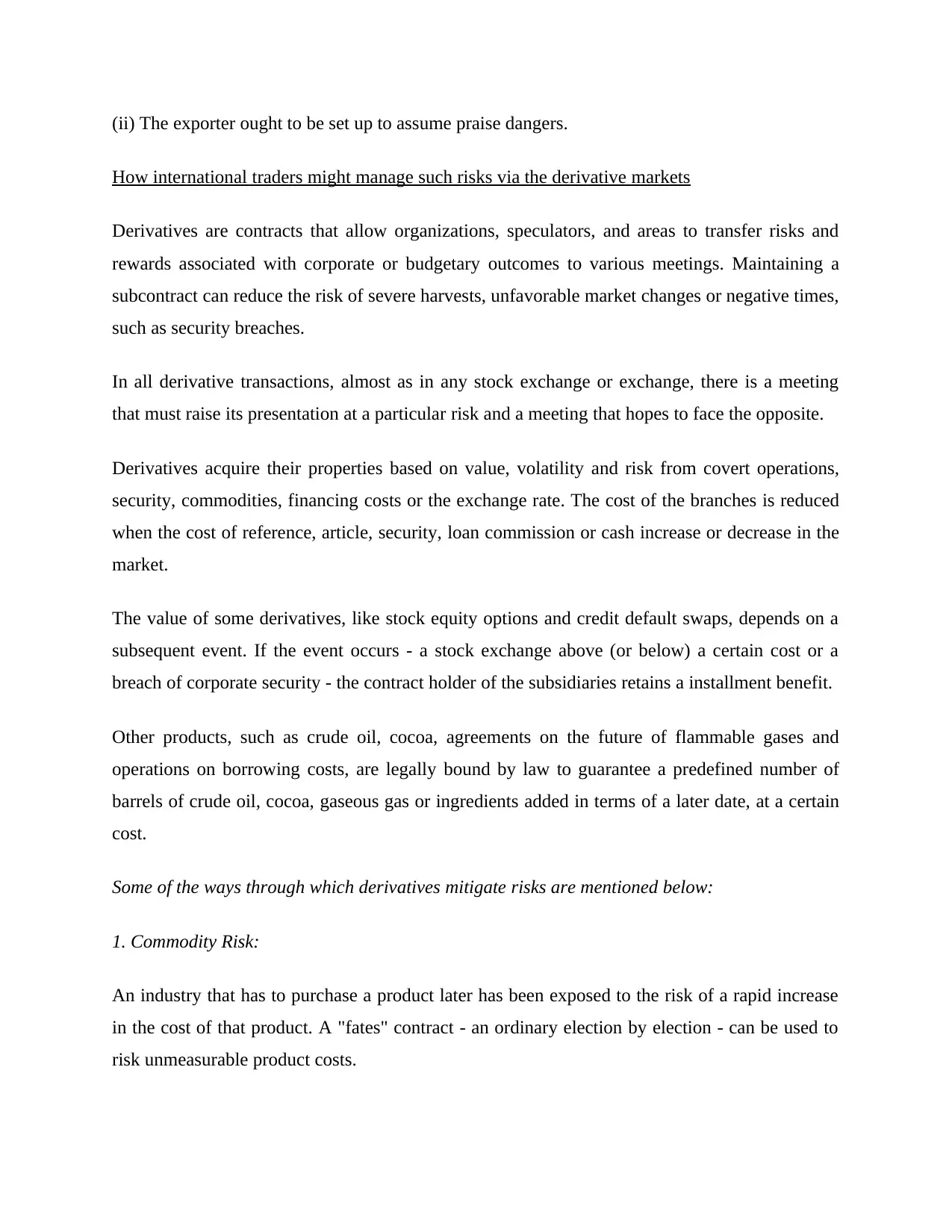
(ii) The exporter ought to be set up to assume praise dangers.
How international traders might manage such risks via the derivative markets
Derivatives are contracts that allow organizations, speculators, and areas to transfer risks and
rewards associated with corporate or budgetary outcomes to various meetings. Maintaining a
subcontract can reduce the risk of severe harvests, unfavorable market changes or negative times,
such as security breaches.
In all derivative transactions, almost as in any stock exchange or exchange, there is a meeting
that must raise its presentation at a particular risk and a meeting that hopes to face the opposite.
Derivatives acquire their properties based on value, volatility and risk from covert operations,
security, commodities, financing costs or the exchange rate. The cost of the branches is reduced
when the cost of reference, article, security, loan commission or cash increase or decrease in the
market.
The value of some derivatives, like stock equity options and credit default swaps, depends on a
subsequent event. If the event occurs - a stock exchange above (or below) a certain cost or a
breach of corporate security - the contract holder of the subsidiaries retains a installment benefit.
Other products, such as crude oil, cocoa, agreements on the future of flammable gases and
operations on borrowing costs, are legally bound by law to guarantee a predefined number of
barrels of crude oil, cocoa, gaseous gas or ingredients added in terms of a later date, at a certain
cost.
Some of the ways through which derivatives mitigate risks are mentioned below:
1. Commodity Risk:
An industry that has to purchase a product later has been exposed to the risk of a rapid increase
in the cost of that product. A "fates" contract - an ordinary election by election - can be used to
risk unmeasurable product costs.
How international traders might manage such risks via the derivative markets
Derivatives are contracts that allow organizations, speculators, and areas to transfer risks and
rewards associated with corporate or budgetary outcomes to various meetings. Maintaining a
subcontract can reduce the risk of severe harvests, unfavorable market changes or negative times,
such as security breaches.
In all derivative transactions, almost as in any stock exchange or exchange, there is a meeting
that must raise its presentation at a particular risk and a meeting that hopes to face the opposite.
Derivatives acquire their properties based on value, volatility and risk from covert operations,
security, commodities, financing costs or the exchange rate. The cost of the branches is reduced
when the cost of reference, article, security, loan commission or cash increase or decrease in the
market.
The value of some derivatives, like stock equity options and credit default swaps, depends on a
subsequent event. If the event occurs - a stock exchange above (or below) a certain cost or a
breach of corporate security - the contract holder of the subsidiaries retains a installment benefit.
Other products, such as crude oil, cocoa, agreements on the future of flammable gases and
operations on borrowing costs, are legally bound by law to guarantee a predefined number of
barrels of crude oil, cocoa, gaseous gas or ingredients added in terms of a later date, at a certain
cost.
Some of the ways through which derivatives mitigate risks are mentioned below:
1. Commodity Risk:
An industry that has to purchase a product later has been exposed to the risk of a rapid increase
in the cost of that product. A "fates" contract - an ordinary election by election - can be used to
risk unmeasurable product costs.
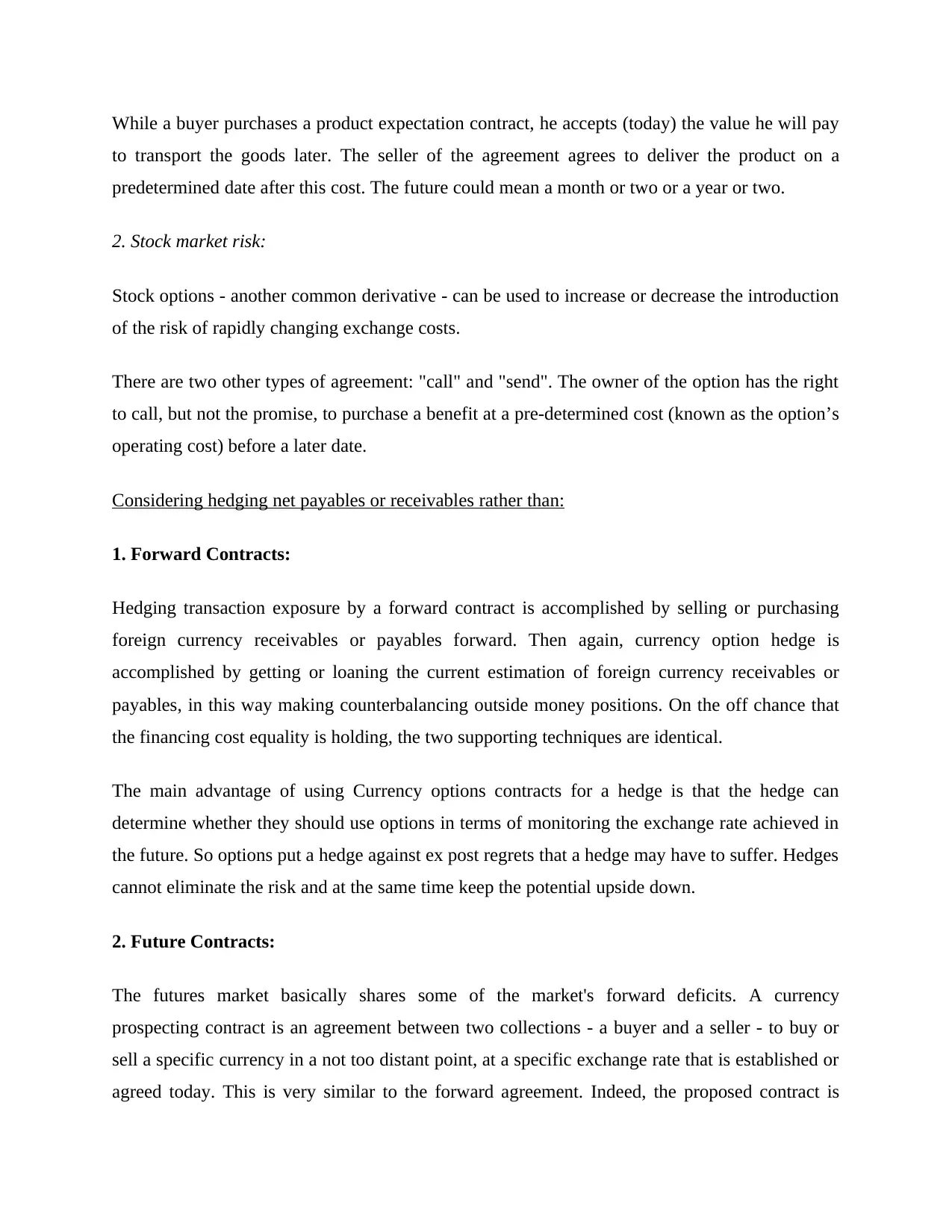
While a buyer purchases a product expectation contract, he accepts (today) the value he will pay
to transport the goods later. The seller of the agreement agrees to deliver the product on a
predetermined date after this cost. The future could mean a month or two or a year or two.
2. Stock market risk:
Stock options - another common derivative - can be used to increase or decrease the introduction
of the risk of rapidly changing exchange costs.
There are two other types of agreement: "call" and "send". The owner of the option has the right
to call, but not the promise, to purchase a benefit at a pre-determined cost (known as the option’s
operating cost) before a later date.
Considering hedging net payables or receivables rather than:
1. Forward Contracts:
Hedging transaction exposure by a forward contract is accomplished by selling or purchasing
foreign currency receivables or payables forward. Then again, currency option hedge is
accomplished by getting or loaning the current estimation of foreign currency receivables or
payables, in this way making counterbalancing outside money positions. On the off chance that
the financing cost equality is holding, the two supporting techniques are identical.
The main advantage of using Currency options contracts for a hedge is that the hedge can
determine whether they should use options in terms of monitoring the exchange rate achieved in
the future. So options put a hedge against ex post regrets that a hedge may have to suffer. Hedges
cannot eliminate the risk and at the same time keep the potential upside down.
2. Future Contracts:
The futures market basically shares some of the market's forward deficits. A currency
prospecting contract is an agreement between two collections - a buyer and a seller - to buy or
sell a specific currency in a not too distant point, at a specific exchange rate that is established or
agreed today. This is very similar to the forward agreement. Indeed, the proposed contract is
to transport the goods later. The seller of the agreement agrees to deliver the product on a
predetermined date after this cost. The future could mean a month or two or a year or two.
2. Stock market risk:
Stock options - another common derivative - can be used to increase or decrease the introduction
of the risk of rapidly changing exchange costs.
There are two other types of agreement: "call" and "send". The owner of the option has the right
to call, but not the promise, to purchase a benefit at a pre-determined cost (known as the option’s
operating cost) before a later date.
Considering hedging net payables or receivables rather than:
1. Forward Contracts:
Hedging transaction exposure by a forward contract is accomplished by selling or purchasing
foreign currency receivables or payables forward. Then again, currency option hedge is
accomplished by getting or loaning the current estimation of foreign currency receivables or
payables, in this way making counterbalancing outside money positions. On the off chance that
the financing cost equality is holding, the two supporting techniques are identical.
The main advantage of using Currency options contracts for a hedge is that the hedge can
determine whether they should use options in terms of monitoring the exchange rate achieved in
the future. So options put a hedge against ex post regrets that a hedge may have to suffer. Hedges
cannot eliminate the risk and at the same time keep the potential upside down.
2. Future Contracts:
The futures market basically shares some of the market's forward deficits. A currency
prospecting contract is an agreement between two collections - a buyer and a seller - to buy or
sell a specific currency in a not too distant point, at a specific exchange rate that is established or
agreed today. This is very similar to the forward agreement. Indeed, the proposed contract is
⊘ This is a preview!⊘
Do you want full access?
Subscribe today to unlock all pages.

Trusted by 1+ million students worldwide
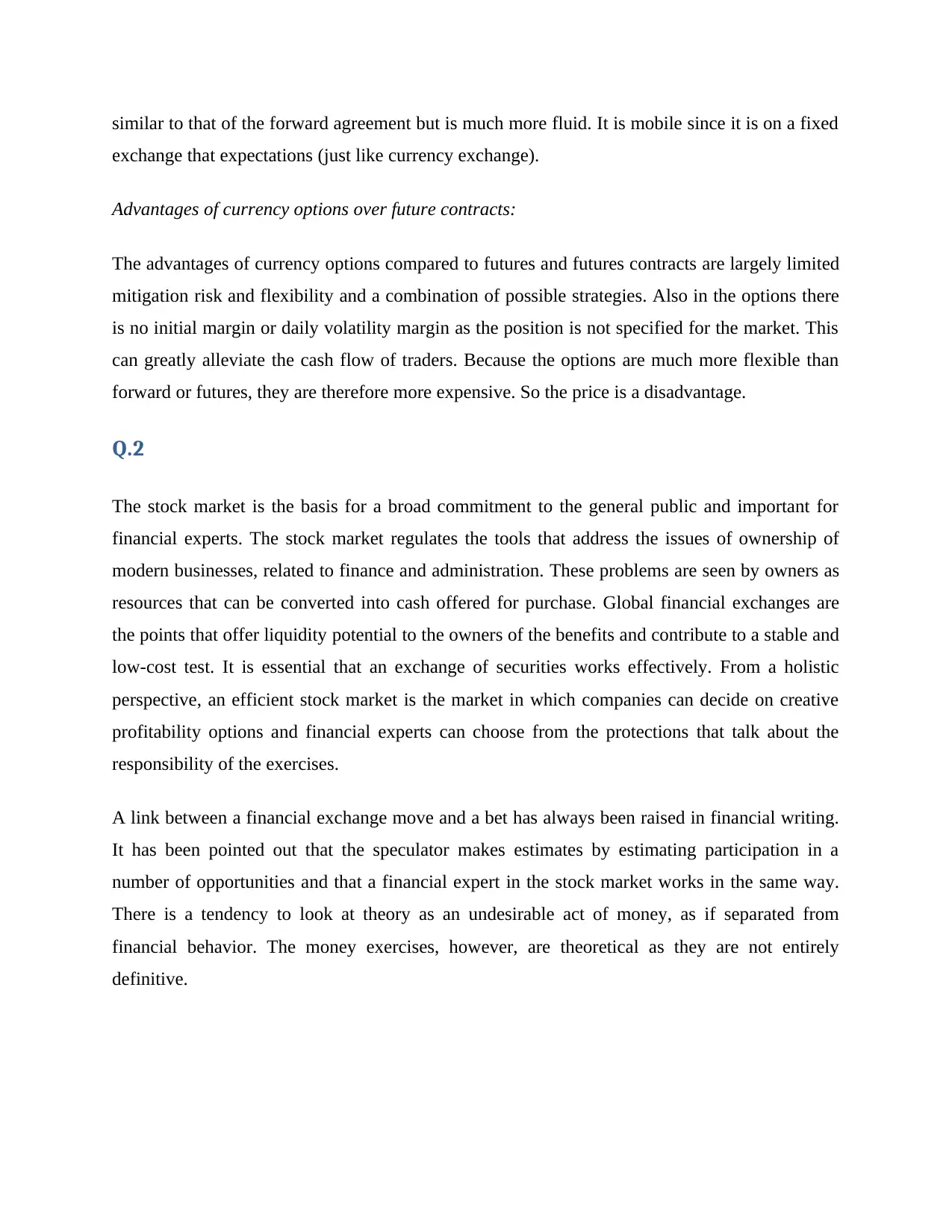
similar to that of the forward agreement but is much more fluid. It is mobile since it is on a fixed
exchange that expectations (just like currency exchange).
Advantages of currency options over future contracts:
The advantages of currency options compared to futures and futures contracts are largely limited
mitigation risk and flexibility and a combination of possible strategies. Also in the options there
is no initial margin or daily volatility margin as the position is not specified for the market. This
can greatly alleviate the cash flow of traders. Because the options are much more flexible than
forward or futures, they are therefore more expensive. So the price is a disadvantage.
Q.2
The stock market is the basis for a broad commitment to the general public and important for
financial experts. The stock market regulates the tools that address the issues of ownership of
modern businesses, related to finance and administration. These problems are seen by owners as
resources that can be converted into cash offered for purchase. Global financial exchanges are
the points that offer liquidity potential to the owners of the benefits and contribute to a stable and
low-cost test. It is essential that an exchange of securities works effectively. From a holistic
perspective, an efficient stock market is the market in which companies can decide on creative
profitability options and financial experts can choose from the protections that talk about the
responsibility of the exercises.
A link between a financial exchange move and a bet has always been raised in financial writing.
It has been pointed out that the speculator makes estimates by estimating participation in a
number of opportunities and that a financial expert in the stock market works in the same way.
There is a tendency to look at theory as an undesirable act of money, as if separated from
financial behavior. The money exercises, however, are theoretical as they are not entirely
definitive.
exchange that expectations (just like currency exchange).
Advantages of currency options over future contracts:
The advantages of currency options compared to futures and futures contracts are largely limited
mitigation risk and flexibility and a combination of possible strategies. Also in the options there
is no initial margin or daily volatility margin as the position is not specified for the market. This
can greatly alleviate the cash flow of traders. Because the options are much more flexible than
forward or futures, they are therefore more expensive. So the price is a disadvantage.
Q.2
The stock market is the basis for a broad commitment to the general public and important for
financial experts. The stock market regulates the tools that address the issues of ownership of
modern businesses, related to finance and administration. These problems are seen by owners as
resources that can be converted into cash offered for purchase. Global financial exchanges are
the points that offer liquidity potential to the owners of the benefits and contribute to a stable and
low-cost test. It is essential that an exchange of securities works effectively. From a holistic
perspective, an efficient stock market is the market in which companies can decide on creative
profitability options and financial experts can choose from the protections that talk about the
responsibility of the exercises.
A link between a financial exchange move and a bet has always been raised in financial writing.
It has been pointed out that the speculator makes estimates by estimating participation in a
number of opportunities and that a financial expert in the stock market works in the same way.
There is a tendency to look at theory as an undesirable act of money, as if separated from
financial behavior. The money exercises, however, are theoretical as they are not entirely
definitive.
Paraphrase This Document
Need a fresh take? Get an instant paraphrase of this document with our AI Paraphraser
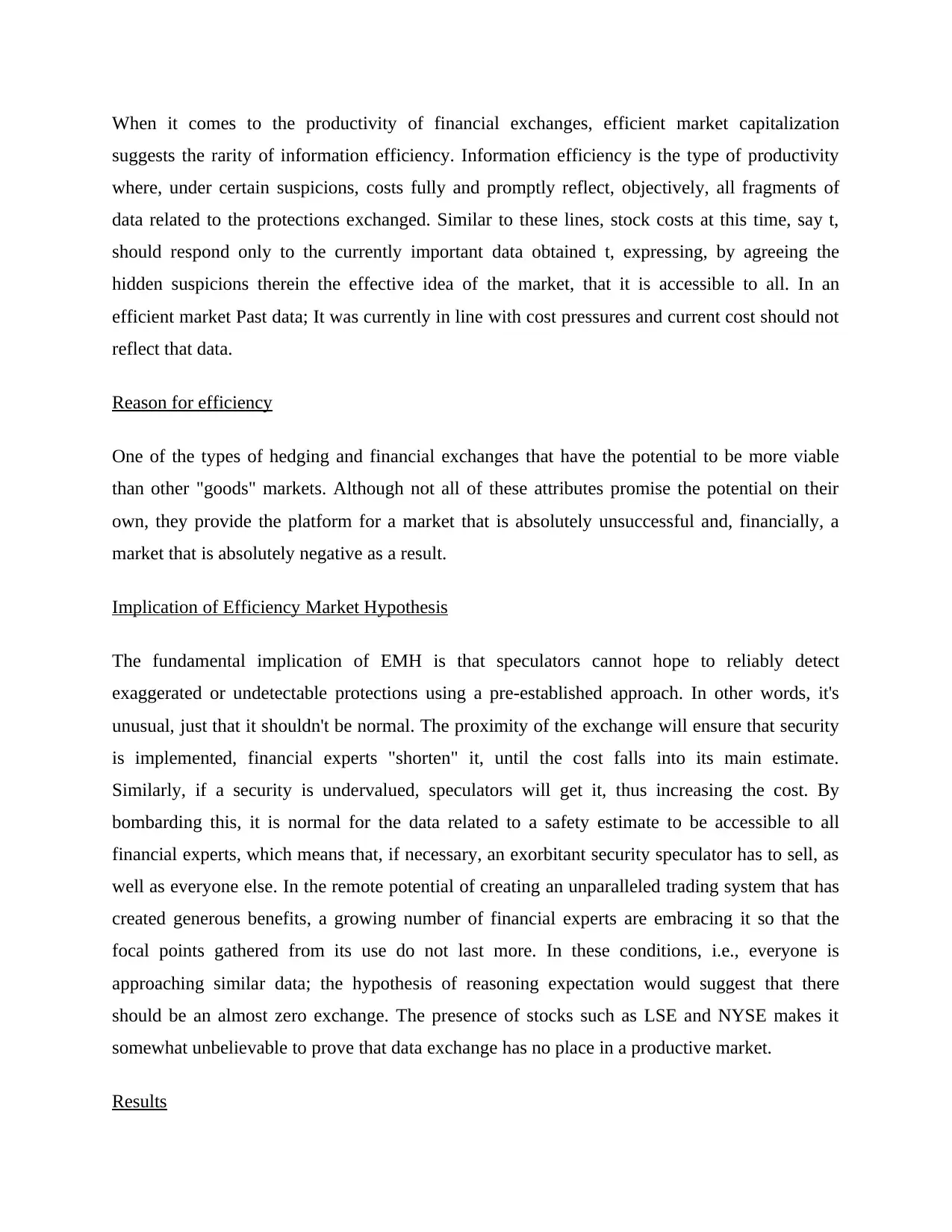
When it comes to the productivity of financial exchanges, efficient market capitalization
suggests the rarity of information efficiency. Information efficiency is the type of productivity
where, under certain suspicions, costs fully and promptly reflect, objectively, all fragments of
data related to the protections exchanged. Similar to these lines, stock costs at this time, say t,
should respond only to the currently important data obtained t, expressing, by agreeing the
hidden suspicions therein the effective idea of the market, that it is accessible to all. In an
efficient market Past data; It was currently in line with cost pressures and current cost should not
reflect that data.
Reason for efficiency
One of the types of hedging and financial exchanges that have the potential to be more viable
than other "goods" markets. Although not all of these attributes promise the potential on their
own, they provide the platform for a market that is absolutely unsuccessful and, financially, a
market that is absolutely negative as a result.
Implication of Efficiency Market Hypothesis
The fundamental implication of EMH is that speculators cannot hope to reliably detect
exaggerated or undetectable protections using a pre-established approach. In other words, it's
unusual, just that it shouldn't be normal. The proximity of the exchange will ensure that security
is implemented, financial experts "shorten" it, until the cost falls into its main estimate.
Similarly, if a security is undervalued, speculators will get it, thus increasing the cost. By
bombarding this, it is normal for the data related to a safety estimate to be accessible to all
financial experts, which means that, if necessary, an exorbitant security speculator has to sell, as
well as everyone else. In the remote potential of creating an unparalleled trading system that has
created generous benefits, a growing number of financial experts are embracing it so that the
focal points gathered from its use do not last more. In these conditions, i.e., everyone is
approaching similar data; the hypothesis of reasoning expectation would suggest that there
should be an almost zero exchange. The presence of stocks such as LSE and NYSE makes it
somewhat unbelievable to prove that data exchange has no place in a productive market.
Results
suggests the rarity of information efficiency. Information efficiency is the type of productivity
where, under certain suspicions, costs fully and promptly reflect, objectively, all fragments of
data related to the protections exchanged. Similar to these lines, stock costs at this time, say t,
should respond only to the currently important data obtained t, expressing, by agreeing the
hidden suspicions therein the effective idea of the market, that it is accessible to all. In an
efficient market Past data; It was currently in line with cost pressures and current cost should not
reflect that data.
Reason for efficiency
One of the types of hedging and financial exchanges that have the potential to be more viable
than other "goods" markets. Although not all of these attributes promise the potential on their
own, they provide the platform for a market that is absolutely unsuccessful and, financially, a
market that is absolutely negative as a result.
Implication of Efficiency Market Hypothesis
The fundamental implication of EMH is that speculators cannot hope to reliably detect
exaggerated or undetectable protections using a pre-established approach. In other words, it's
unusual, just that it shouldn't be normal. The proximity of the exchange will ensure that security
is implemented, financial experts "shorten" it, until the cost falls into its main estimate.
Similarly, if a security is undervalued, speculators will get it, thus increasing the cost. By
bombarding this, it is normal for the data related to a safety estimate to be accessible to all
financial experts, which means that, if necessary, an exorbitant security speculator has to sell, as
well as everyone else. In the remote potential of creating an unparalleled trading system that has
created generous benefits, a growing number of financial experts are embracing it so that the
focal points gathered from its use do not last more. In these conditions, i.e., everyone is
approaching similar data; the hypothesis of reasoning expectation would suggest that there
should be an almost zero exchange. The presence of stocks such as LSE and NYSE makes it
somewhat unbelievable to prove that data exchange has no place in a productive market.
Results
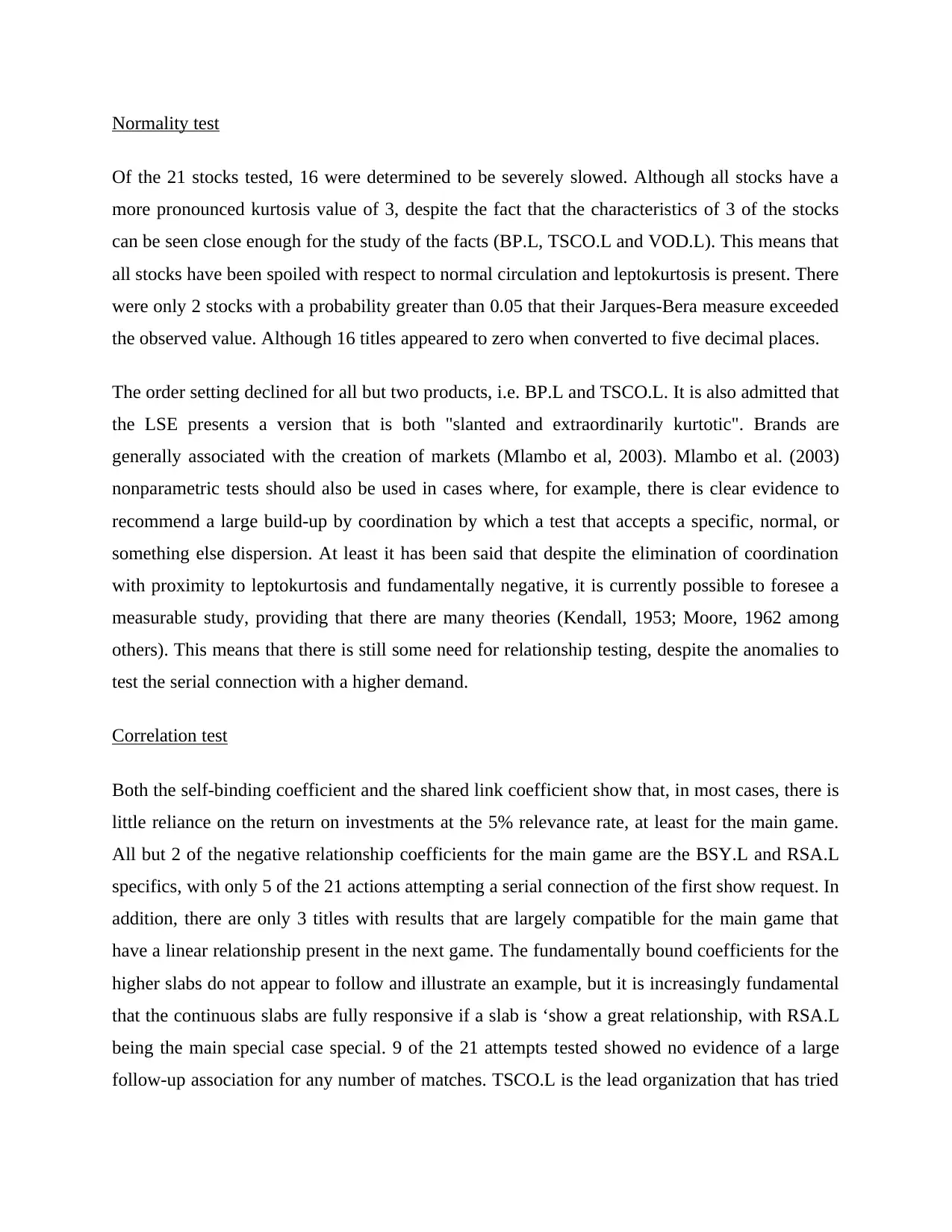
Normality test
Of the 21 stocks tested, 16 were determined to be severely slowed. Although all stocks have a
more pronounced kurtosis value of 3, despite the fact that the characteristics of 3 of the stocks
can be seen close enough for the study of the facts (BP.L, TSCO.L and VOD.L). This means that
all stocks have been spoiled with respect to normal circulation and leptokurtosis is present. There
were only 2 stocks with a probability greater than 0.05 that their Jarques-Bera measure exceeded
the observed value. Although 16 titles appeared to zero when converted to five decimal places.
The order setting declined for all but two products, i.e. BP.L and TSCO.L. It is also admitted that
the LSE presents a version that is both "slanted and extraordinarily kurtotic". Brands are
generally associated with the creation of markets (Mlambo et al, 2003). Mlambo et al. (2003)
nonparametric tests should also be used in cases where, for example, there is clear evidence to
recommend a large build-up by coordination by which a test that accepts a specific, normal, or
something else dispersion. At least it has been said that despite the elimination of coordination
with proximity to leptokurtosis and fundamentally negative, it is currently possible to foresee a
measurable study, providing that there are many theories (Kendall, 1953; Moore, 1962 among
others). This means that there is still some need for relationship testing, despite the anomalies to
test the serial connection with a higher demand.
Correlation test
Both the self-binding coefficient and the shared link coefficient show that, in most cases, there is
little reliance on the return on investments at the 5% relevance rate, at least for the main game.
All but 2 of the negative relationship coefficients for the main game are the BSY.L and RSA.L
specifics, with only 5 of the 21 actions attempting a serial connection of the first show request. In
addition, there are only 3 titles with results that are largely compatible for the main game that
have a linear relationship present in the next game. The fundamentally bound coefficients for the
higher slabs do not appear to follow and illustrate an example, but it is increasingly fundamental
that the continuous slabs are fully responsive if a slab is ‘show a great relationship, with RSA.L
being the main special case special. 9 of the 21 attempts tested showed no evidence of a large
follow-up association for any number of matches. TSCO.L is the lead organization that has tried
Of the 21 stocks tested, 16 were determined to be severely slowed. Although all stocks have a
more pronounced kurtosis value of 3, despite the fact that the characteristics of 3 of the stocks
can be seen close enough for the study of the facts (BP.L, TSCO.L and VOD.L). This means that
all stocks have been spoiled with respect to normal circulation and leptokurtosis is present. There
were only 2 stocks with a probability greater than 0.05 that their Jarques-Bera measure exceeded
the observed value. Although 16 titles appeared to zero when converted to five decimal places.
The order setting declined for all but two products, i.e. BP.L and TSCO.L. It is also admitted that
the LSE presents a version that is both "slanted and extraordinarily kurtotic". Brands are
generally associated with the creation of markets (Mlambo et al, 2003). Mlambo et al. (2003)
nonparametric tests should also be used in cases where, for example, there is clear evidence to
recommend a large build-up by coordination by which a test that accepts a specific, normal, or
something else dispersion. At least it has been said that despite the elimination of coordination
with proximity to leptokurtosis and fundamentally negative, it is currently possible to foresee a
measurable study, providing that there are many theories (Kendall, 1953; Moore, 1962 among
others). This means that there is still some need for relationship testing, despite the anomalies to
test the serial connection with a higher demand.
Correlation test
Both the self-binding coefficient and the shared link coefficient show that, in most cases, there is
little reliance on the return on investments at the 5% relevance rate, at least for the main game.
All but 2 of the negative relationship coefficients for the main game are the BSY.L and RSA.L
specifics, with only 5 of the 21 actions attempting a serial connection of the first show request. In
addition, there are only 3 titles with results that are largely compatible for the main game that
have a linear relationship present in the next game. The fundamentally bound coefficients for the
higher slabs do not appear to follow and illustrate an example, but it is increasingly fundamental
that the continuous slabs are fully responsive if a slab is ‘show a great relationship, with RSA.L
being the main special case special. 9 of the 21 attempts tested showed no evidence of a large
follow-up association for any number of matches. TSCO.L is the lead organization that has tried
⊘ This is a preview!⊘
Do you want full access?
Subscribe today to unlock all pages.

Trusted by 1+ million students worldwide
1 out of 21
Related Documents
Your All-in-One AI-Powered Toolkit for Academic Success.
+13062052269
info@desklib.com
Available 24*7 on WhatsApp / Email
![[object Object]](/_next/static/media/star-bottom.7253800d.svg)
Unlock your academic potential
Copyright © 2020–2025 A2Z Services. All Rights Reserved. Developed and managed by ZUCOL.





